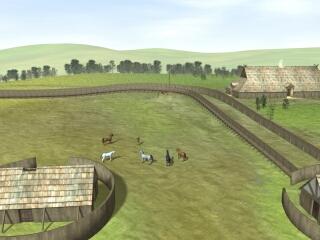| |

|
| |

|
You can also see:
Or go back to:
|
|
|
Yeavering Saxon Royal Palace: The Great Enclosure
The Great Enclosure is often referred to as a stock enclosure, although its origins may have been very different.
Visible from aerial photographs as a large penannular enclosure with massive circular entrance works, it appears at
first glance more like a huge prehistoric defended settlement rather than a simple stock enclosure. Inside, no
dwellings or structures were to be found, but a much older prehistoric burial mound was incorporated and even
respected by the later enclosure walls. Further, the burial mound had a post added to it to act, perhaps, as a
focal point for what Hope-Taylor called "ritual observances".
The origins of the enclosure are not clear. The excavations suggested that it might have been built as early as Roman
times. So by the time of Edwin, it was already ancient. So what activities require a large communal space, with stout
walls and no permanent buildings?
The excavator, Brian Hope-Taylor, favoured an interpretation that used this site, in Edwin's time, as a large
cattle corral or the scene of local traditional events. As Anglo-Saxon kings expressed their power by travelling
through their estates, exacting dues and administering justice, such a corral would be used to round up cattle or
horses brought in as taxes from local people. They would inevitably be the source of food for the feasting, which
took place in the Great Hall during Edwin's stay, while Paulinus spread the word of his god.
This reconstruction is based on evidence obtained during Hope-Taylor's excavations
|
|